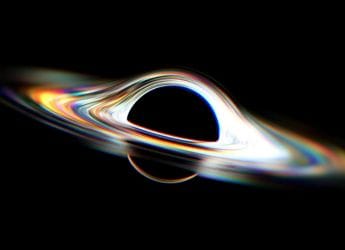- Home
- Science
- Science News
- NASA’s Juno Mission Captures Huge Storms on Jupiter’s Surface
NASA’s Juno Mission Captures Huge Storms on Jupiter’s Surface
Juno is on its extended mission and will continue to investigate Jupiter through September 2025 or until the end of its life.

Photo Credit: NASA/JPL-Caltech/SwRI/MSSS
The storms on Jupiter can be quite powerful and massive with a height of 50 kilometres
The Juno Jupiter mission of US space agency NASA has completed its 43rd close flyby of the biggest planet of our solar system. And, in the process, it has delivered a phenomenal picture of the surface. The shot features fascinating vortices or hurricane-like spiral wind patterns forming near Jupiter's north pole. The Juno mission flew past close to Jupiter on July 5 this year. It clicked the striking photo using its JunoCam instrument.
While the storms look enchanting in the picture, they can be quite powerful and massive with a height of 50 kilometres and spread hundreds of miles across the planet. They also hold vital information about Jupiter's atmosphere. Studying their formation can give scientists an insight into the fluid dynamics and cloud chemistry that create Jupiter's other atmospheric features.
Check out the image below, posted by NASA on Twitter:
Scientists will be analysing the different shapes, colours, and sizes of the vortices seen on the planet. The difference in colour and shape is also seen in the cyclones that form on Earth. For instance, cyclones which spin counter-clockwise in the northern hemisphere and clockwise in the southern hemisphere and anti-cyclones which behave the other way differ in colour and shape.
NASA has launched a citizen science project called Jovian Vortex Hunter which allows people to locate vortices in the picture and help the space agency categorise them.
NASA's Juno spacecraft left for its five-year journey on August 5, 2011, and arrived at Jupiter on July 4, 2016. It took five years to reach the planet and entered the 53-day polar orbit stretching from above the planet's cloud tops to the outer reaches of the Jovian magnetosphere.
Juno collected a trove of data during its initial 35 orbits and captured breathtaking views of Jupiter and its satellites. Now, Juno is on its extended mission and will continue to investigate Jupiter through September 2025 or until the end of its life.
Get your daily dose of tech news, reviews, and insights, in under 80 characters on Gadgets 360 Turbo. Connect with fellow tech lovers on our Forum. Follow us on X, Facebook, WhatsApp, Threads and Google News for instant updates. Catch all the action on our YouTube channel.
Related Stories
- Samsung Galaxy Unpacked 2025
- ChatGPT
- Redmi Note 14 Pro+
- iPhone 16
- Apple Vision Pro
- Oneplus 12
- OnePlus Nord CE 3 Lite 5G
- iPhone 13
- Xiaomi 14 Pro
- Oppo Find N3
- Tecno Spark Go (2023)
- Realme V30
- Best Phones Under 25000
- Samsung Galaxy S24 Series
- Cryptocurrency
- iQoo 12
- Samsung Galaxy S24 Ultra
- Giottus
- Samsung Galaxy Z Flip 5
- Apple 'Scary Fast'
- Housefull 5
- GoPro Hero 12 Black Review
- Invincible Season 2
- JioGlass
- HD Ready TV
- Laptop Under 50000
- Smartwatch Under 10000
- Latest Mobile Phones
- Compare Phones
- OnePlus 15R
- Realme Narzo 90x 5G
- Realme Narzo 90 5G
- Vivo S50 Pro Mini
- Vivo S50
- OPPO Reno 15c
- Redmi Note 15 5G
- Redmi Note 15 Pro 5G
- Asus ProArt P16
- MacBook Pro 14-inch (M5, 2025)
- Infinix Xpad Edge
- OnePlus Pad Go 2
- OnePlus Watch Lite
- Just Corseca Skywatch Pro
- Acerpure Nitro Z Series 100-inch QLED TV
- Samsung 43 Inch LED Ultra HD (4K) Smart TV (UA43UE81AFULXL)
- Asus ROG Ally
- Nintendo Switch Lite
- Haier 1.6 Ton 5 Star Inverter Split AC (HSU19G-MZAID5BN-INV)
- Haier 1.6 Ton 5 Star Inverter Split AC (HSU19G-MZAIM5BN-INV)

















